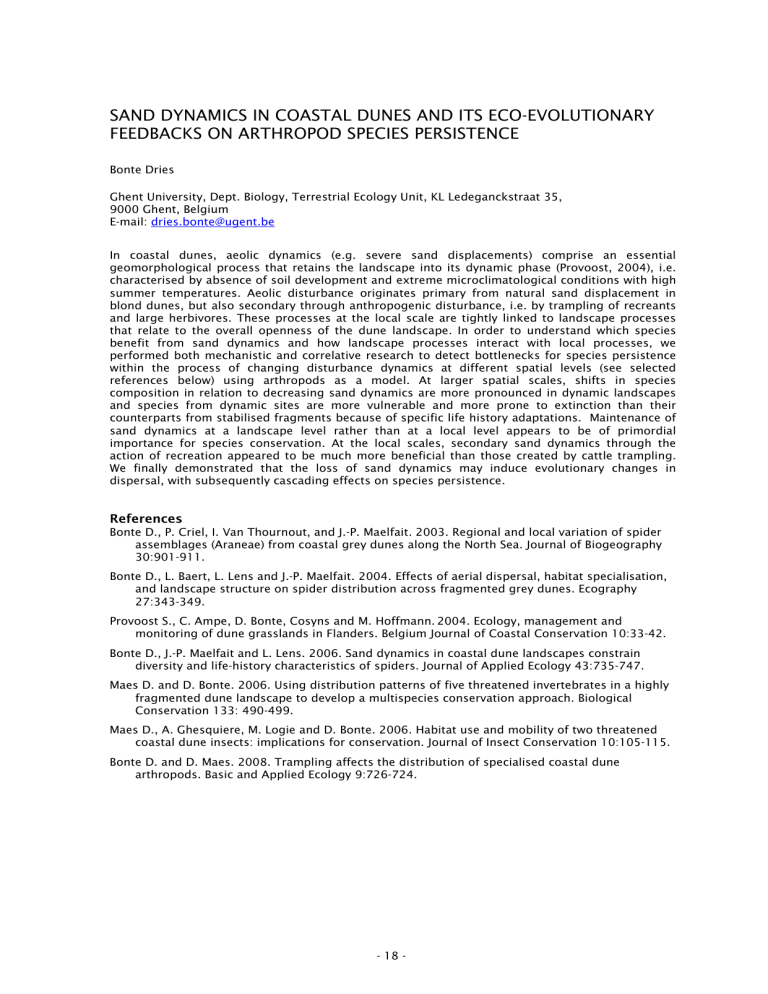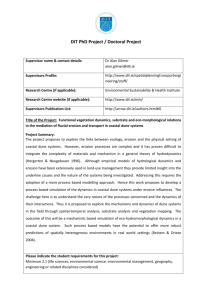SAND DYNAMICS IN COASTAL DUNES AND ITS ECO-EVOLUTIONARY

SAND DYNAMICS IN COASTAL DUNES AND ITS ECO-EVOLUTIONARY
FEEDBACKS ON ARTHROPOD SPECIES PERSISTENCE
Bonte Dries
Ghent University, Dept. Biology, Terrestrial Ecology Unit, KL Ledeganckstraat 35,
9000 Ghent, Belgium
E-mail: dries.bonte@ugent.be
In coastal dunes, aeolic dynamics (e.g. severe sand displacements) comprise an essential geomorphological process that retains the landscape into its dynamic phase (Provoost, 2004), i.e. characterised by absence of soil development and extreme microclimatological conditions with high summer temperatures. Aeolic disturbance originates primary from natural sand displacement in blond dunes, but also secondary through anthropogenic disturbance, i.e. by trampling of recreants and large herbivores. These processes at the local scale are tightly linked to landscape processes that relate to the overall openness of the dune landscape. In order to understand which species benefit from sand dynamics and how landscape processes interact with local processes, we performed both mechanistic and correlative research to detect bottlenecks for species persistence within the process of changing disturbance dynamics at different spatial levels (see selected references below) using arthropods as a model. At larger spatial scales, shifts in species composition in relation to decreasing sand dynamics are more pronounced in dynamic landscapes and species from dynamic sites are more vulnerable and more prone to extinction than their counterparts from stabilised fragments because of specific life history adaptations. Maintenance of sand dynamics at a landscape level rather than at a local level appears to be of primordial importance for species conservation. At the local scales, secondary sand dynamics through the action of recreation appeared to be much more beneficial than those created by cattle trampling.
We finally demonstrated that the loss of sand dynamics may induce evolutionary changes in dispersal, with subsequently cascading effects on species persistence.
References
Bonte D., P. Criel, I. Van Thournout, and J.-P. Maelfait. 2003. Regional and local variation of spider assemblages (Araneae) from coastal grey dunes along the North Sea. Journal of Biogeography
30:901-911.
Bonte D., L. Baert, L. Lens and J.-P. Maelfait. 2004. Effects of aerial dispersal, habitat specialisation, and landscape structure on spider distribution across fragmented grey dunes. Ecography
27:343-349.
Provoost S., C. Ampe, D. Bonte, Cosyns and M. Hoffmann.
2004. Ecology, management and monitoring of dune grasslands in Flanders. Belgium Journal of Coastal Conservation 10:33-42.
Bonte D., J.-P. Maelfait and L. Lens. 2006. Sand dynamics in coastal dune landscapes constrain diversity and life-history characteristics of spiders. Journal of Applied Ecology 43:735-747.
Maes D. and D. Bonte. 2006. Using distribution patterns of five threatened invertebrates in a highly fragmented dune landscape to develop a multispecies conservation approach. Biological
Conservation 133: 490-499.
Maes D., A. Ghesquiere, M. Logie and D. Bonte. 2006. Habitat use and mobility of two threatened coastal dune insects: implications for conservation. Journal of Insect Conservation 10:105-115.
Bonte D. and D. Maes. 2008. Trampling affects the distribution of specialised coastal dune arthropods. Basic and Applied Ecology 9:726-724.
- 18 -






